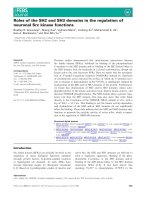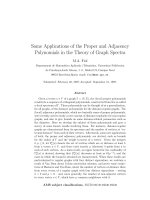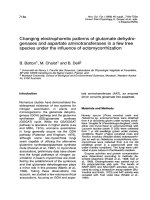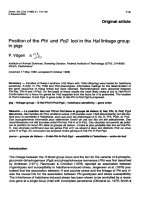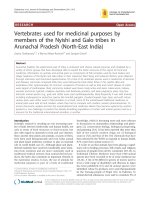Patterns of the incremental and radical innovation in singapore design driven enterprises
Bạn đang xem bản rút gọn của tài liệu. Xem và tải ngay bản đầy đủ của tài liệu tại đây (2.71 MB, 184 trang )
PATTERNS OF THE INCREMENTAL AND RADICAL
INNOVATION IN SINGAPORE DESIGN-DRIVEN ENTERPRISES
WEI HANGSHUAI
(B.ENG, Zhe Jiang University)
A THESIS SUBMITTED
FOR THE DEGREE OF MASTER OF ARTS (INDUSTRIAL DESIGN)
DEPARTMENT OF ARCHITECTURE
NATIONAL UNIVERSITY OF SINGAPORE
2009
ACKNOWLEDGEMENT
I would like to acknowledge the contributions of the following groups and individuals for
their assistance and encouragement during my research project.
I would like to thank my supervisor, Dr Yen Ching Chiuan for the great amount of time and
dedication he spent in guiding me through my research project. During the past two years, I
have learnt a great amount in the design field under his teaching.
I appreciate all interviewees who assisted me by participating in the data collection. Thank
you MeiYun, XiaoMing, Valerie and YanXue for proof-reading my English.
I am grateful to my classmates: Jiang Hao and Xu Xiaofeng for their help in my research
program, as well as all CASA colleagues whom I shared an impressive two years with.
Thank you to my Mom, Dad and sister for their support and encouragement during the two
years of Master Degree program.
Finally, I appreciate all the people who helped me, and encouraged me in my NUS studies.
i
CONTENTS
ACKNOWLEDGEMENT............................................................................................I
CONTENTS................................................................................................................. II
SUMMARY ................................................................................................................. V
LIST OF TABLES.................................................................................................... VII
LIST OF FIGURES ...................................................................................................IX
1.
AN INTRODUCTION TO THE THESIS .......................................................... 1
1.1 Introduction ...................................................................................................... 1
1.2 An introduction to the issues related to product design and innovation ........... 1
1.3 Focus of the thesis ............................................................................................ 2
1.4 Research aims & objectives.............................................................................. 3
1.5 Outline of the thesis.......................................................................................... 3
2.
A REVIEW OF THE LITERATURE ................................................................. 5
2.1 Introduction ...................................................................................................... 5
2.2 An introduction of innovation........................................................................... 6
2.2.1 What is innovation? ............................................................................................ 6
2.2.2 Types of innovation ............................................................................................ 9
2.2.3 Degree of innovation ........................................................................................ 10
2.2.4 The importance of innovation........................................................................... 14
2.2.5 Innovation process............................................................................................ 15
2.2.6 Innovation strategy ........................................................................................... 22
2.2.7 Innovation policy (network, alliance, partnership)........................................... 24
2.2.8 Marketing with innovation ............................................................................... 28
2.3 An introduction to design ............................................................................... 31
2.3.1 What is design?................................................................................................. 31
2.3.2 Types of design disciplines ............................................................................... 32
2.3.3 Design knowledge and skill.............................................................................. 33
2.3.4 Value of design ................................................................................................. 35
2.3.5 Design process.................................................................................................. 37
2.3.6 Design and innovation ...................................................................................... 40
2.3.7 Design with marketing...................................................................................... 44
2.4 Summary......................................................................................................... 45
2.5 Emerging research questions .......................................................................... 46
3.
RESEARCH METHODOLOGY FRAMEWORK ......................................... 47
ii
3.1 Introduction .................................................................................................... 47
3.2 Methodological framework ............................................................................ 48
3.3 Case study....................................................................................................... 49
3.3.1 Why case study? ............................................................................................... 49
3.3.2 What’s case study?............................................................................................ 50
3.3.3 Single verses multiple cases ............................................................................. 50
3.3.4 Selection of cases.............................................................................................. 53
3.3.5 Source of evidence for case studies .................................................................. 54
3.3.6 Analysis of evidence and information .............................................................. 56
3.4 Limitations of the research ............................................................................. 57
3.5 Summary......................................................................................................... 58
4.
A DESCRIPTION ON THE FINDINGS OF CASE STUDY ......................... 59
4.1 Introduction .................................................................................................... 59
4.2 COM1 ............................................................................................................. 59
4.2.1 Company background....................................................................................... 59
4.2.2 Background information of innovation ............................................................ 59
4.2.3 Characteristics of product innovation............................................................... 60
4.2.4 Innovation process, design impact and collaboration....................................... 62
4.3 COM2 ............................................................................................................. 64
4.3.1 Company background....................................................................................... 64
4.3.2 Background information of innovation ............................................................ 65
4.3.3 Characteristics of product innovation............................................................... 66
4.3.4 Innovation process, design impact and collaboration....................................... 67
4.4 COM3 ............................................................................................................. 71
4.4.1 Company background....................................................................................... 71
4.4.2 Background information of innovation ............................................................ 71
4.4.3 Characteristics of product innovation............................................................... 72
4.4.4 Innovation process, design impact and collaboration....................................... 73
4.5 COM4 ............................................................................................................. 76
4.5.1 Company background....................................................................................... 76
4.5.2 Innovation information ..................................................................................... 76
4.5.3 Characteristics of product innovation............................................................... 77
4.5.4 Innovation process, design impact and collaboration....................................... 77
4.6 COM5 ............................................................................................................. 81
4.6.1 Company background....................................................................................... 81
4.6.2 Innovation information ..................................................................................... 81
4.6.3 Characteristics of product innovation............................................................... 82
4.6.4 Innovation process, design impact and collaboration....................................... 84
4.7 COM6 ............................................................................................................. 87
4.7.1 Company background....................................................................................... 87
4.7.2 Innovation information ..................................................................................... 87
iii
4.7.3 Characteristics of product innovation............................................................... 88
4.7.4 Innovation process, design impact and collaboration....................................... 89
4.8 Summary of the description on the findings................................................... 91
5.
AN ANALYSIS AND DISCUSSION OF THE RESEARCH FINDINGS ..... 96
5.1 Introduction .................................................................................................... 96
5.2 Innovation impact in business performance ................................................... 97
5.3 The relationship between innovativeness and product characteristics ......... 100
5.4 Understanding of innovation process ........................................................... 104
5.5 Design features in the innovation process .................................................... 113
5.5.1 Design involvement in the innovation process ............................................... 115
5.5.2 Four levels of design knowledge in the product innovation ........................... 116
5.5.3 Design knowledge required in incremental and radical innovation................ 119
5.6 Innovation collaboration............................................................................... 120
5.7 Summary....................................................................................................... 122
6.
CONCLUSIONS AND DIRECTIONS FOR FUTURE RESEARCH ......... 124
6.1 Introduction .................................................................................................. 124
6.2 Issues about product design and innovation ................................................. 124
6.2.1 Innovation strategy: recognize radical innovation.......................................... 124
6.2.2 Manage incremental and radical innovation in different way ........................ 125
6.2.3 Design patterns ............................................................................................... 125
6.3 Further research ............................................................................................ 126
6.3.1 Quantitative survey for broader research........................................................ 126
6.3.2 Patterns of incremental and radical innovation in other industries................. 127
6.3.3 Product design and innovation in less design-driven companies.................... 127
REFERENCE ........................................................................................................... 128
APPENDICES .......................................................................................................... 136
Appendix I Case Studies Report......................................................................... 137
Appendix II Questionnaire ................................................................................. 168
iv
SUMMARY
Today, companies are under intensive competition more than ever. They are compelled to
develop incremental products for current users’ needs and explore radical products for the
future. Thus, it is important to identify how to manage incremental and radical innovations in
balancing acts. This research addresses the patterns of incremental and radical innovation in
product characteristics, product development process, design requirements and impacts, as
well as collaboration within Singapore design-driven enterprises. This study identifies the
associations between the incremental and radical innovation, as well as offers an insight on
how to manage and operate product design and innovation successfully.
This study is exploratory and adopts a qualitative research methodology, i.e. case studies. Six
cases were undertaken through in-depth interviews with company’s senior designers or design
project managers, documentation analysis and product design comparisons. The essential
qualitative case description led to the development of a visual-designed pattern for the ease of
understanding the two innovation models.
The research findings demonstrated that:
• Incremental innovation and radical innovation have different objectives in business
strategic directions. Incremental innovation is for profit and revenue while radical
innovation is to explore new market potential and boost brand image.
• Products resulting from incremental innovation and radical innovation possess very
different characteristics. Incremental innovation involves redesign and upgrading that is
always technology-oriented, while radical innovation could either be design &
creativity-oriented or new technology –oriented.
• Most of the companies share a similar general process with incremental and radical
innovation, but the contents and emphasis are different. Radical innovation focuses on
research phase (fuzzy front end) with a more iterative and concurrent process than that of
v
incremental innovation.
• In radical innovation, designers take on the role of a leader and participator, and they are
required to possess four levels of knowledge: basic operations & skills, tacit knowledge,
design strategic knowledge and visionary capabilities. Incremental innovation and radical
innovation requires different aspects of design knowledge.
• Most Singapore companies have their own research capabilities and only seek to
collaborate in the engineering and manufacturing aspect to reduce cost, risk and acquire
new technologies.
The research findings suggest that, besides incremental innovation, companies should
recognize radical innovation as a weapon to create new market and boost branding. Radical
innovation involves great manpower and requires managers to operate in a more flexible way
due to its high uncertainty of market and technologies. Design plays critical role in the whole
product innovation process, which requires design students to be trained in a holistic manner
to gain broad and integrative knowledge and skills during their academic education required
for their future design work.
vi
LIST OF TABLES
Table 2.1 Types of innovations .................................................................................................. 9
Table 2.2 Comparison of incremental and radical innovation management ............................ 14
Table 2.3 Product innovation strategies ................................................................................... 23
Table 2.4 Freeman’s innovation strategy ................................................................................. 24
Table 2.5 Comparison of closed innovation and open innovation ........................................... 25
Table 2.6 Types of collaboration .............................................................................................. 28
Table 2.7 Use of models and methods of market research across NPD activities ................... 29
Table 2.8 Two models of market learning................................................................................ 30
Table 2.9 Types of design......................................................................................................... 33
Table 2.10 Design knowledge and skills.................................................................................. 34
Table 2.11 Levels of design in strategy perspective................................................................. 36
Table 2.12 Design phases, objective and visual outputs .......................................................... 40
Table 2.13 Design impacts in the stage-gate process ............................................................... 43
Table 2.14 The relation of market objective and design outcome............................................ 45
Table 3.1 Comparison of holistic and embedded case studies ................................................. 53
Table 4.1 Number of innovations launched in COM1 ............................................................. 60
Table 4.2 Objectives of incremental and radical innovation in COM1.................................... 60
Table 4.3 Product information about Data Com- ADSL and wireless multimedia streamer ... 61
Table 4.4 Comparison of incremental versus radical product characteristics in COM1 .......... 61
Table 4.5 Patterns of incremental and radical innovation in COM1 ........................................ 64
Table 4.6 Number of innovations launched in COM2 ............................................................. 65
Table 4.7 Objectives of incremental and radical innovation in COM2.................................... 65
Table 4.8 Product information about Massage chair-UYOYO and Uspace............................. 66
Table 4.9 Comparison of incremental versus radical product characteristics in COM2 .......... 67
Table 4.10 Patterns of incremental and radical innovation in COM2 ...................................... 70
Table 4.11 Number of innovations launched in COM3 ........................................................... 71
Table 4.12 Objectives of incremental and radical innovation in COM3.................................. 71
Table 4.13 Product information about Display- LUMI and Phoenix electrostatic speaker...... 72
Table 4.14 Comparison of incremental versus radical product characteristics in COM3 ........ 73
Table 4.15 Patterns of incremental and radical innovation in COM3 ...................................... 75
Table 4.16 Number of innovations launched in COM4 ........................................................... 76
Table 4.17 Objectives of incremental and radical innovation in COM4.................................. 77
Table 4.18 Product information about Remote Control-Riva Wheel and Living Colors......... 78
Table 4.19 Comparison of incremental versus radical product characteristics in COM4 ........ 78
Table 4.20 Patterns of incremental and radical innovation in COM4 ...................................... 80
Table 4.21 Number of innovations launched in COM5 ........................................................... 81
Table 4.22 Objectives of incremental and radical innovation in COM5.................................. 82
Table 4.23 Product information about two-way radio and bone conduction headset .............. 83
vii
Table 4.24 Comparison of incremental versus radical product characteristics in COM5 ........ 84
Table 4.25 Patterns of incremental and radical innovation in COM5 ...................................... 86
Table 4.26 Number of innovations launched in COM6 ........................................................... 87
Table 4.27 Objectives of incremental and radical innovation in COM6.................................. 87
Table 4.28 Product information about Projector-M209X and Crystal monitor........................ 88
Table 4.29 Comparison of incremental versus radical product characteristics in COM6 ........ 89
Table 4.30 Patterns of incremental and radical innovation in COM6 ...................................... 91
Table 5.1 Numbers of incremental and radical innovation in six case studies......................... 97
Table 5.2 Comparison about the objectives of incremental and radical innovation in six cases
................................................................................................................................................. 98
Table 5.3 Incremental innovation characteristic of six companies ........................................ 101
Table 5.4 Radical innovation characteristic of six companies ............................................... 101
Table 5.5 Reports on the association between incremental and radical innovation process .. 110
Table 5.6 Innovation process about concurrent and iterative..................................................111
Table 5.7 Six companies’ design involvement in incremental and radical innovation .......... 113
Table 5.8 Six companies’ design impacts in incremental and radical innovation .................. 114
Table 5.9 Designer requirements in incremental and radical innovation within six companies
............................................................................................................................................... 115
Table 5.10 Innovation collaboration of six companies .......................................................... 120
viii
LIST OF FIGURES
Figure 2.1 The framework of innovation management and NPD (Trott, 1998)......................... 8
Figure 2.2 An industrial timeline of radical and incremental innovation................................. 11
Figure 2.3 The innovation framework (Davila, et al., 2005) ................................................... 12
Figure 2.4 The innovation framework (Veryzer, 1998)............................................................ 13
Figure 2.5 Five generations of innovation processes (Rothwell, 1994)................................... 16
Figure 2.6 The Stage-Gate model of new product development (adapted from Cooper
et al., 2002)............................................................................................................. 18
Figure 2.7 The product development funnel (adapted from Clark and Wheelwright, 1993) ... 18
Figure 2.8 Four stages of innovation process (Gaynor, 2002) ................................................. 19
Figure 2.9 The innovation process (Davila, et al., 2005) ......................................................... 19
Figure 2.10 The product innovation development process (adapted from Crawford, 1997) ... 20
Figure 2.11 The radical innovation process system (adapted from Veryzer, 1998) ................. 21
Figure 2.12 Radical innovation process (adapted from Chesbrough, et al., 2006) .................. 22
Figure 2.13 Closed innovation paradigm (Chesbrough, et al., 2006) ...................................... 26
Figure 2.14 Open innovation paradigm (Chesbrough, et al., 2006)......................................... 26
Figure 2.15 Main areas of design (Shirley and Henn, 1988) ................................................... 32
Figure 2.16 Three levels of design capabilities (Hytönen et al., 2004).................................... 34
Figure 2.17 The phase of the design process (French, 1985)................................................... 38
Figure 2.18 Overview of design process (adapted from Pahl and Beitz, 1984)....................... 39
Figure 2.19 Improving innovation process through design (de Mozota, 2003) ....................... 42
Figure 3.1 Research process of this study................................................................................ 48
Figure 3.2 Basic types of design for case studies (Yin, 2003) ................................................. 52
Figure 4.1 Incremental innovation process in COM1 .............................................................. 62
Figure 4.2 Radical innovation process in COM1..................................................................... 63
Figure 4.3 Incremental innovation process in COM2 .............................................................. 68
Figure 4.4 Radical innovation process in COM2..................................................................... 69
Figure 4.5 Incremental innovation process in COM3 .............................................................. 74
Figure 4.6 Radical innovation process in COM3..................................................................... 74
Figure 4.7 incremental innovation process in COM4 .............................................................. 79
Figure 4.8 Radical innovation process in COM4..................................................................... 79
Figure 4.9 Incremental innovation process .............................................................................. 85
Figure 4.10 Radical innovation process ................................................................................... 85
Figure 4.11 Incremental innovation process in COM6 ............................................................ 90
Figure 4.12 Radical innovation process in COM6................................................................... 90
ix
Figure 5.1 Comparison of product characteristics between incremental and radical
innovation ............................................................................................................ 102
Figure 5.2 Market information of incremental and radical products ..................................... 102
Figure 5.3 “Five steps” innovation process based on six case studies................................... 105
x
1. AN INTRODUCTION TO THE THESIS
1.1 Introduction
This chapter aims to provide an introduction to the area of the research and an outline of the
thesis structure. The focus of the thesis is to identify the patterns of the incremental and
radical innovation in Singapore design-driven enterprises, in relation to the design
characteristics of the innovative outcome, the process of innovation, design involvement and
impacts, and external collaboration within the innovations. This chapter is divided into four
parts: 1.) issues surrounding the product design and innovation, 2.) the focus of the study, 3.)
research aim and objectives, 4.) outline of the thesis structure.
1.2 An introduction to the issues related to product design and
innovation
There is a growing consensus that design and innovation are essential to sustain competitive
advantage and ensure long-term success through bringing new products to the customers fast
and efficiently (Gemser & Leenders, 2000; Kaplan, 2003; Von Stamm 2003). However,
managing innovation is not an easy task. Companies are compelled by intensive competition
pressure to develop incremental innovative products for current user’s needs and explore
radical innovative products for future (Boer & Gertsen, 2003). The nomenclatures associated
with incremental and radical innovation were proposed as early as in 1960’s (Robertson,
1967). Past studies only focused on either incremental innovation or radical innovation
individually in the aspects of product development process, design investment, marketing and
organizational structure, etc (Veryzer, 2005; O’Connor, 1998; Bessant et al, 1994). It is
unclear whether there is any association between the patterns of incremental and radical
innovation and whether these two innovation models can be operated in the same way. Design
1
as an innovation tool was emphasized by scholars and practitioners that it relates not only to
aesthetics, but also to other aspects such as human factor, ease of manufacture and product
performance. For example, Philip and Alexander (1984) described design as a potent strategic
innovation tool to enhance products, environment, communications, and corporate identity.
Bruce and Bessant (2002) indicated design is a facet of both incremental and radical
innovation. In addition, innovation alliance and collaboration as a strategic police in product
development were widely adopted recently. Chesbrough (2006) defined it as “open
innovation” and suggested firms could and should use internal ideas as well as external ideas.
Many other scholars also agreed that alliances, outsource and partnerships with other
companies, institutions and universities are the essential source in the innovation process
(Freeman, 1991; Quinn, 2000; Huston and Sakkab, 2006). So it is essential to determine three
important but unclear issues: innovation process and its outcome, design involvement &
impacts and collaboration in the incremental and radical innovation, for in-depth
understanding on how to manage these two innovation models effectively and successfully,
which will be a good contribution for today’s product innovation theory framework.
The research is conducted by using multiple case studies. Data will be collected through
interviewing R&D managers and industrial designers, and other relevant documents. The
findings and discussion of case studies will be presented in Chapter 4 and Chapter 5.
1.3 Focus of the thesis
The thesis focuses on developing the framework of incremental and radical innovation mainly
associated with process, design factors and collaboration through the study of Singapore
design-driven companies. Five issues in both incremental and radical innovation (objectives
of innovation, product characteristics, product development process, design involvement &
impacts, and external collaboration) will be assessed through a comparative analysis to
identify the common and different patterns between these two innovation models. All the six
companies selected in this case study are grounded in the Singapore-based industries and are
2
excellent in the product design and innovation. In this respect, this research reflects the latest
patterns of design and innovation in Singapore design-driven firms. It will also serve as a
theoretical reference for other scholars who are engaged in researching product design and
innovation areas.
1.4 Research aims & objectives
The aim of the thesis is to provide the patterns of the incremental and radical innovation
within Singapore context. More specifically, the thesis attempts to achieve the following
research objectives:
• To identify the importance of incremental and radical innovation in the business strategy.
• To explore the orientation of incremental and radical innovation through analyzing product
characteristics.
• To establish the patterns of incremental and radical innovation process and identify the
association between both of them.
• To explore the design impacts in the incremental and radical innovation, as well as develop
an understanding on the design knowledge requirements within such a process.
• To gain an understanding on the use of innovation alliance and collaboration within
innovation process
1.5 Outline of the thesis
Beside the introduction, the thesis consists of another five chapters. A brief overview of each
chapter is as follows:
Chapter two: literature review
This chapter presents an overview of the product design and innovation literature and a variety
3
of other relevant literature such as business strategy, market research, and new product
development, etc.
Chapter three: overview of methodology
An overview of research methodology is presented. It also explains the approach of using the
case study method in this research.
Chapter four: reports on the findings of the case studies
The main findings from six cases on the patterns of incremental and radical innovation
associated with the importance of innovation, product characteristics, process, design
involvement and impacts, as well as collaboration are presented for future analysis and
discussion.
Chapter five: an analysis and discussion of the research findings
This chapter provides an analysis and discussion based on the comparison and summarization
of the descriptive data from the research findings.
Chapter six: conclusions and directions for the future research
This chapter concludes the research findings and identifies potential design and innovation
issues emerged from this study.
Reference and appendices will be presented at the end of the thesis.
4
2. A REVIEW OF THE LITERATURE
“Tomorrow’s businesses must innovate or deteriorate. They must design or die.”
(Janice Kirkpatrick, designer, at the launch of Design in business week, 1998)
“Companies must innovate if they are to survive in the new millennium.
Producing good products will no longer be enough. They must be clever, original,
well designed and creatively marketed.”
(Andrew Summer, CEO Design Council, Design Council, 1999)
2.1 Introduction
This chapter is to present the literature review of product innovation and other relevant fields,
including design, new product development (NPD), and market research, etc.
Literature on design and innovation is very diverse. This research mainly focuses on the
comparison of the patterns between incremental and radical innovation with regards to the
associated factors, such as design, process and external collaborative efforts. Relevant theories
from the literature will be reviewed and presented to provide a clear picture of:
• Concept of innovation,
• Types of innovation,
• Degree of innovation: incremental and radical innovation,
• Innovation process,
• The innovation policy: collaboration and alliance,
• Design concept, skills and process,
• Marketing research related to design and innovation.
Finally, a set of research questions will be identified based on the literature review in order to
provide the research directions for this study.
5
According to the content of literature review, this chapter can be divided into three parts:
• Innovation: concept of innovation, innovation models, innovation process, innovation
policy, and marketing research with innovation.
• Design: concept of design, design knowledge, design process and its relation with
innovation and marketing.
• Summary of the main points and questions raised by the literature review.
2.2 An introduction of innovation
2.2.1 What is innovation?
The concept of innovation is very broad and can be understood in a variety of ways. Many
scholars have given their own definition of “innovation”. One of the most comprehensive
definitions is provided by Myers and Marquis (1969):
“Innovation is not a single action but a total process of interrelated sub
processes. It is not just the conception of a new idea, nor the invention of a new
device, nor the development of a new market. The process is all these things
acting in an integrated fashion.”
Harvard Business Essentials (Anon, 2003) provided a more elaborate definition:
“Innovation is the embodiment, combination, or synthesis of knowledge in
original, relevant, valued new products, processes, or services.”
Most scholars including those above assumed innovation as a process focusing on the
commercial and practical application of ideas or creativity. For example, Von Stamm (2003)
claimed that “innovation is creativity plus implementation”. MIT professor Ed Roberts (Anon,
2003) defined innovation as “invention plus exploitation”. For more elaboration, Trott (1998)
argued the innovation as a management process from ideas to product launch:
6
“Innovation is the management of all the activities involved in the process of idea
generation, technology development, manufacturing and marketing of a new (or
improved) products or manufacturing process or equipment.”
Gaynor (2002) shared this view and provided a simple equation of innovation:
“Innovation= invention + implementation + commercialization”
Based on the definitions of innovation above, it is emphasised in this study that innovation
should be a management process that implements from the initial creative ideas to product
commercialization. Whether or not innovation is successful depends on its positioning in
creativity, process management and market implementation.
Though the concept of innovation is presented, it is still necessary to clarify three terms used
extensively and synonymously with innovation: creativity, design and invention, in order to
help people understand innovation more clearly and explicitly. Bruce and Bessant (2002)
compared the first 3 terms and defined them as:
• Innovation is “the successful application of new ideas in practices in the form of new or
improved products, services or processes”.
• Creativity is “the ability to combine ideas in new ways to solve problems and exploit
opportunities”.
• Design is “the purposive application of creativity throughout the process of innovation”.
For the comparison of innovation and invention, Trott (1998) stated that:
• Invention is “the conception of the idea, whereas innovation is the subsequent translation
of the invention into the economy”.
Based on the definitions, we can see the concepts of the term “invention” and “creativity” are
similar, however, invention is used to describe the conception of a new idea and creativity is
linked to the ability of creating ideas. Design is the application of creativity and innovation in
practice.
7
As mentioned earlier, innovation is considered a process by many researchers. It is also
important to clarify the confused concepts with New Product Development (NPD) and
Research and Development (R&D). R&D has traditionally been regarded as the management
of scientific research and new product development (Trott, 1998). Twiss (1992) offered a
widely accepted definition:
• R&D is “the purposeful and systematic use of scientific knowledge to improve man’s lot
even though some of its manifestations do not meet with universal approval.”
• New product development “concerns the management of the disciplines involved in the
development of new product.”
• Innovation management is “to develop necessary conditions for innovation to occur.”
Based on the definitions, the R&D, innovation, and NPD are overlapped in some areas, but
the activities in innovation management are much more than R&D while activities in R&D
are more than that in NPD. Figure 2.1 presents the association between innovation
management and NPD.
Figure 2.1 The framework of innovation management and NPD (Trott, 1998)
8
2.2.2 Types of innovation
Indeed, innovation widely exists in every industry. It is often categorised by subject nature.
Trott (1998) indicated seven types of innovation based on subject focuses as shown in Table
2.1.
Table 2.1 Types of innovations
Type of innovation
Definition/Example
Product innovation
The development of a new or improved product
Process innovation
The development of a new manufacturing process
Organizational innovation
A new venture division, a new internal communication system,
introduction of a new accounting procedure
Management innovation
TQM (total quality management) systems, BPR (business
process re-engineering), introduction of SAP R3
Production innovation
Quality circles, just-in-time (JIT) manufacturing system, new
production planning software, e. g. MRP II ,new inspection
system
Commercial/marketing innovation
New financing arrangements ,new sales approach, e.g. direct
marketing
Service innovation
Telephone financial services
Source: Trott (1998)
Carr (1999) argued innovation occurred in ten categories. They are “customer experience,
brand, channel, service, product systems, product performance, core processes, enabling
processes, networking and business models”. He further argued that every industry has a
different degree of focus in each innovation category above. For example, PC industry mainly
focuses on product performance innovation while other industry categories may be relatively
weaker in this aspect of innovation. Airline mainly focuses on service and networking
innovation and other innovations are not robust in this area. This implies that companies
should map its own innovation patterns and strategies to spot areas of strength and weakness.
For this study, it focuses on the product innovation. Other categories such as service
9
innovation and production innovation are not in this research topic. Five aspects (product
form, function, technology, material and usability) will be explored to identify what the
innovative product characteristic is.
2.2.3 Degree of innovation
In the literature review, there are various bases applied to determine the innovativeness.
Crawford (1994) provided three levels of innovation, i.e. pioneering, adaptation and imitation.
Another similar base is high, medium, and low. (Kleinschmidt and Cooper, 1991) Robertson
(1967) added time factors and classified innovativeness as: continuous, dynamically
continuous, and discontinuous. Based on strategic directions, Freeman (1982) argued there
were four broad innovation strategies in terms of innovativeness: offensive, defensive,
imitative and dependent, as well as traditional and opportunist.
Generally, two common types of innovation according to the project innovativeness, i.e.
incremental innovation and radical innovation have been widely used in the field of
product/technology innovation. “Continuous innovation” is sometimes used as a synonym for
incremental
innovation.
For
the
radical
innovation,
terms
like
“discontinuous”,
“breakthrough”, “revolutionary” have been used to show the nature of radical innovation.
(Veryzer, 1998) In general, the definitions of incremental and radical innovation are (Anon,
2003):
• Incremental innovation: is generally understood to exploit existing forms or technologies.
• Radical innovation: is something new to the world and a departure from existing
technology or methods.
Studies also attempted to exploit the relations between the incremental and radical product
innovations. Harvard Business essentials (Anon, 2003) developed a theoretical timeline in
which incremental and radical innovations take place shown in Figure 2.2.
10
Figure 2.2 An industrial timeline of radical and incremental innovation
This illustration presents how progress is made through numbers of incremental innovation
until radical innovation appears. When progress takes an abrupt leap forward (radical
innovation), incremental innovation then resumes. Thus, radical and incremental innovations
often operate hand in hand.
Davila, et al. (2005) further defined these two types of innovation and provided an innovation
matrix to explain the association between incremental and radical innovations (see Figure 2.3).
Two dimensions were introduced by them to depict the degree of innovation. The
“technology” dimension refers to the degree of product expanding technological capabilities.
The “business model” dimension refers to the level of market and customer benefit. In this
view of innovation, there are three types of innovation (incremental, semi-radical, radical)
presented.
Regarding the incremental innovation, the product is utilizing improved technology and
launches to the existing market. Although they may be new, they are still not very innovative.
The semi-radical products utilizing the existing technology to the new market or using new
11
technology to the existing market have an impact on customers in terms of product benefits or
use. However, the most revolutionary products are those that apply the new technologies in
the new market. Those radical products incorporate advanced technologies over long periods
of time to enhance benefits. However, radical innovation also has several serious challenges,
i.e. risky, expensive, and taking longer time to explore. Though incremental projects may be
less innovative than radical, they are safer, cheaper and more likely to produce favourable
results. That is the reason why most companies prefer incremental innovation to radical
innovation. (Anon, 2003)
Figure 2.3 The innovation framework (Davila, et al., 2005)
Veryzer (1998) provided a similar innovation framework for incremental and radical
innovation. In his theory, the “technological capability” and “product capability” dimensions
are presented to delineate the various levels of innovation. Four types of innovation are
illustrated: continuous (incremental innovation), technologically discontinuous (radical
innovation), commercially discontinuous (radical innovation), and technologically and
commercially discontinuous (radical innovation).
12
Figure 2.4 The innovation framework (Veryzer, 1998)
Studies also explored the relations between incremental and radical innovation, as well as
some issues with respect to innovation, such as design and marketing. Ali (1994) suggested
the development of incremental or radical products should depend on the companies’
capabilities, along with the circumstances of different projects and market characteristics. He
further indicated that the role of marketing is very different in the development of pioneering
and incremental products. Veryzer (1998) identified radical innovation process as more
exploratory and less customer driven, which is quite different from incremental innovation
process. Veryzer (2005) also explored the role of marketing and industrial design in radical
innovation, which suggested the role of marketing and ID are altered and involve increased
challenges related to the validation of key assumptions and product application directions.
Based on the review above, this study will focus on the use of incremental and radical
innovations.
To provide a precise and clear understanding, as well as help interviewees in
the study to understand these concepts easily, below are the working definition of both terms:
• Incremental product innovation: new product changed a little through redesigning,
modifying, updating and improvement.
• Radical product innovation: new products improved revolutionarily compared to the
previous products or new products never existing in the market before.
13
Innovation is not only about the products, it also needs to be managed in a rational system.
For incremental and radical innovations, they have differences in the innovation management.
(Leifer et al., 2000) Table 2.2 presents those differences.
Table 2.2 Comparison of incremental and radical innovation management
System
Strategic planning
Incremental innovation
Radical innovation
Extrapolate current business model.
Explore new technical approaches
Identify gaps
and business models
Traditional tools; focused groups,
Market research
conjoint
analysis,
surveys,
prototyping.
Lot of upfront planning, definition of
Project planning
milestones, clear objectives. Plan
suffers small modifications.
Process formalization
Partnerships
External monitoring
Anthropological,
observation,
experiential, experimentation.
Define broad goals, little detailed
planning, but heavy reliance on
experimentation.
Plan
constantly
revisited.
High; based on stage gates
Low; based on small team dynamics
Collaboration over various projects long-term agreements
Partner
provides
access
to
capabilities that the organization
lacks.
Monitor current competitors and
Monitoring idea generation places-
current eco-system.
universities, labs, start-ups.
Source: Leifer et al., (2000)
2.2.4 The importance of innovation
This is a mantra that “innovate or die” (Getz and Robinson, 2003) implies companies must
keep on innovating for survival. In high intensive competition, new products launched to the
market will inevitably change the basis of competition. Companies are compelled to innovate
for sustaining competitive advantage (Trott, 1998).
Kaplan (2003) claimed that innovation
can create the capabilities to bring products to market fast and efficiently and avoid value
proposition being imitated. However, as mentioned above, innovation can be divided into two
categories based on the level of innovativeness: incremental and radical innovation. Past
researches only defined the importance of innovation generally without classification and few
literatures explored the importance of these two innovation models respectively. Thereby, it
14

